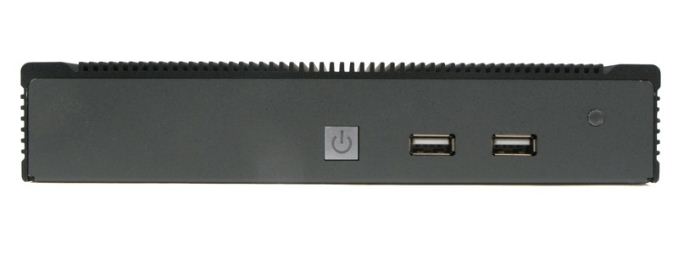Logic Supply Core-ML320 Fanless Industrial NUC Review
by Ganesh T S on April 30, 2014 3:45 PM EST- Posted in
- NUC
- Industrial PC
- Passive Cooling
- Logic Supply
Concluding Remarks
Coming to the business end of the review, it is clear that Logic Supply has been able to deliver effectively on the promise of a fanless NUC. The chassis has been designed to adapt the default NUC configuration for the requirements of industrial PCs. The online ordering page provides lots of options for customization. Even though the capacity choice of the SSDs in the review unit wasn't great, consumers do have the option of going in for larger sized SSDs if desired. That said, the DRAM options are top of the line, with full 1600 MHz support (instead of the 1333 MHz that some vendors put in, in order to cut down power consumption / thermal load).
Our only points of complaint are related to the size of the primary drive and the possibility of a better thermal design. On the former point, 32 GB simply shouldn't be an option, particularly when Windows is being presented as a OS of choice. A bare install followed by a couple of major updates is enough to cause disk space problems. It is also recommended that SSDs keep a fair amount of space free in order to maintain performance. A 32 GB mSATA drive simply can't be recommended. On the latter point, we found that parts of the chassis reached temperatures of 170 F+ under sustained heavy loading. A larger surface area for heat dissipation could have made the unit maintain a lower temperature profile even under high load.
Despite these minor quibbles (neither of which are show-stoppers), we have to say that Logic Supply's Core-ML320 is an excellent option for consumers looking for a passively cooled NUC. Its industrial components lend itself to a multitude of applications such as digital signage, kiosks and the like (even in harsh environments). For DIY builds and those finding the cost of a full-blown pre-built system too high, Logic Supply also sells the chassis standalone (ML320) for $139.











31 Comments
View All Comments
PCfan720 - Wednesday, April 30, 2014 - link
The base system is around $650, which is only a couple hundred bucks more than the standard NUC with a fan that Intel offers. A couple hundred bucks isn't bad for a completely sealed and fanless unit.WithoutWeakness - Thursday, May 1, 2014 - link
The NUC is also barebones. The price of comparable RAM and an MSATA SSD should be included in the price of the NUC for a fair comparison.eBob - Thursday, May 1, 2014 - link
This isn't really intended for a home or office user. When you have things running on the factory floor, reliability becomes a more overriding concern. These systems often end up running ten and even twenty years and often without software updates. I would imagine that a lot of these systems are destined to be locked in control cabinets with other hardware and forgotten about unless something goes wrong.Morawka - Thursday, May 1, 2014 - link
how did you build a NUC for under 300 when the barebones is $365? and that's not even counting $50 RAM, $70 Intel Wireless and $60 hard drive + $6 Power CordHrel - Wednesday, April 30, 2014 - link
What's gong on with the Habey on the 7zip test? Shouldn't Gigabyte still be way ahead?ganeshts - Wednesday, April 30, 2014 - link
We weren't able to run 7-Zip on the BRIX Pro (1) configuration because we no longer have access to that particular configuration. You can see updated benchmarks in our second part of the BRIX Pro review that will use different DRAM / storage. I will be posting that shortly.senthil.c - Wednesday, April 30, 2014 - link
It is very disappointing that most NUC does not comes with the IR sensor built-in, since these kind of PC's are mostly used in home theatre environment, IR sensor is a must needed feature.PCfan720 - Thursday, May 1, 2014 - link
The ML320 does have an IR sensor, it's pictured in the main image and listed in the spec table on the Logic Supply site (http://www.logicsupply.com/core-ml320/). Did you just mean that in general most NUC systems don't have one?Antronman - Wednesday, April 30, 2014 - link
Wouldn't make bad HTPCs.No IR, but not bad. A little bit on the pricey side though...for 1000-1300USD you're not looking at an HTPC, but a low-end gaming PC.
harshw - Thursday, May 1, 2014 - link
There's also the Akasa Newton H. It's smaller, cheaper ( in the UK at least. US prices are a laugh ) and with a bit of modding for LEDs - it is perfectly acceptable as a HTPCMine does 41c/50c for the CPU/SSD at an ambient of 27c
http://www.scan.co.uk/products/akasa-newton-h-alum...
The default LEDs for all these cases are usually a blindingly bright blue for power and an anemic green/yellow for HDD. I modded mine to have a warm daylight dim white LED for power and a dim blue for HDD activity. Wish manufacturers had more sense ...